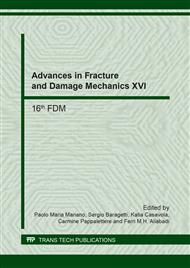[1]
Feraboli, P. and M. Miller, Damage resistance and tolerance of carbon/epoxy composite coupons subjected to simulated lightning strike. Composites Part A: Applied Science and Manufacturing, 2009. 40(6): pp.954-967.
DOI: 10.1016/j.compositesa.2009.04.025
Google Scholar
[2]
Gou, J., et al., Carbon nanofiber paper for lightning strike protection of composite materials. Composites Part B: Engineering, 2010. 41(2): pp.192-198.
DOI: 10.1016/j.compositesb.2009.06.009
Google Scholar
[3]
Kostopoulos, V., et al., A critical review of nanotechnologies for composite aerospace structures. CEAS Space Journal, 2016: pp.1-23.
Google Scholar
[4]
Hirano, Y., et al., Artificial lightning testing on graphite/epoxy composite laminate. Composites Part A: Applied Science and Manufacturing, 2010. 41(10): pp.1461-1470.
DOI: 10.1016/j.compositesa.2010.06.008
Google Scholar
[5]
Lago, F., et al., A numerical modelling of an electric arc and its interaction with the anode: part III. Application to the interaction of a lightning strike and an aircraft in flight. Journal of Physics D: Applied Physics, 2006. 39(10): p.2294.
DOI: 10.1088/0022-3727/39/10/045
Google Scholar
[6]
Abdelal, G. and A. Murphy, Nonlinear numerical modelling of lightning strike effect on composite panels with temperature dependent material properties. Composite Structures, 2014. 109: pp.268-278.
DOI: 10.1016/j.compstruct.2013.11.007
Google Scholar
[7]
Liu, Z., et al., Combining analysis of coupled electrical-thermal and blow-off impulse effects on composite laminate induced by lightning strike. Applied Composite Materials, 2015. 22(2): pp.189-207.
DOI: 10.1007/s10443-014-9401-8
Google Scholar
[8]
Dong, Q., et al., Coupled electrical-thermal-pyrolytic analysis of carbon fiber/epoxy composites subjected to lightning strike. Polymer, 2015. 56: pp.385-394.
DOI: 10.1016/j.polymer.2014.11.029
Google Scholar
[9]
Ogasawara, T., Y. Hirano, and A. Yoshimura, Coupled thermal–electrical analysis for carbon fiber/epoxy composites exposed to simulated lightning current. Composites Part A: Applied Science and Manufacturing, 2010. 41(8): pp.973-981.
DOI: 10.1016/j.compositesa.2010.04.001
Google Scholar
[10]
Muñoz, R., et al., Modeling lightning impact thermo-mechanical damage on composite materials. Applied Composite Materials, 2014. 21(1): pp.149-164.
DOI: 10.1007/s10443-013-9377-9
Google Scholar
[11]
Soykasap, O., S. Karakaya, and M. Colakoglu, Simulation of lightning strike damage in carbon nanotube doped CFRP composites. Journal of Reinforced Plastics and Composites, 2016. 35(6): pp.504-515.
DOI: 10.1177/0731684415618458
Google Scholar
[12]
Condon, E., Aircraft Lightning: Requirements, Component Testing, Aircraft Testing and Certification. The University of Kansas Continuing Education, (2012).
Google Scholar
[13]
Soykasap, O., et al., Finite Element Modelling of CNT-Doped CFRP Plates for Lightning Strike Damage, in Smart Intelligent Aircraft Structures (SARISTU)2016, Springer. pp.825-837.
DOI: 10.1007/978-3-319-22413-8_44
Google Scholar


